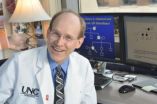(Press-News.org) The effect of a high-fat meal on blood vessel walls can vary among individuals depending on factors such as their waist size and triglyceride levels, suggests new research at UC Davis.
The new research reinforces the link between belly fat, inflammation and thickening of the arterial linings that can lead to heart disease and strokes.
Triglycerides are types of fat molecules, commonly associated with "bad cholesterol," known to increase risk of inflammation of the endothelium, the layer of cells that lines arteries.
"The new study shows that eating a common fast food meal can affect inflammatory responses in the blood vessels," said Anthony Passerini, assistant professor of biomedical engineering at UC Davis, who led the project.
"Our techniques allowed us to measure the inflammatory potential of an individual's lipids outside of the body and to correlate that with easily measured characteristics that could be used to help better understand a person's risk for vascular disease," Passerini said.
Passerini collaborated with Scott Simon, professor of biomedical engineering at UC Davis, to develop cell culture models to mimic the properties of blood vessels. They wanted to learn how triglyceride levels can cause endothelial inflammation, and find a way to assess an individual's inflammatory potential.
They recruited 61 volunteers with high and normal fasting triglyceride levels and a range of waist sizes, then measured levels of triglyceride particles in their blood after they ate a typical fast food breakfast from a major fast food franchise: two breakfast sandwiches, hash browns and orange juice.
Passerini's team found that after eating the high-fat meal, the size of a type of a particle called triglyceride-rich lipoprotein (TGRL) varied directly with the individual's waist size and preexisting blood triglyceride level. These particles can bind to the endothelium, triggering inflammation and an immune response that brings white blood cells to repair the damage. Over time, this leads to atherosclerosis.
The researchers tested whether TGRL particles from the volunteers' blood could cause cultured endothelial cells in the laboratory to express markers for inflammation.
There was a mixed response: individuals with both a waist size over 32 inches (not terribly large by most standards) and high triglyceride levels had large lipoprotein particles that bound easily to the endothelial cells and caused inflammation in response to an immune chemical "trigger."
The TGRLs only caused inflammation when exposed to this immune molecule, which suggests that people with existing low-grade inflammation may be more susceptible to endothelial dysfunction related to triglyceride "spikes" that occur after eating high-fat meals, Passerini said.
In people who are predisposed, repeated episodes of inflammation could lead to atherosclerosis. Passerini's lab is continuing to investigate how abdominal obesity, high triglyceride levels and inflammation can lead to atherosclerosis.
###
The findings are published online in the journal American Journal of Physiology - Heart and Circulatory Physiology. The other authors of the paper, all at the UC Davis Department of Biomedical Engineering, are: graduate student Ying Wang, staff researcher John Schulze, clinical coordinator Nadine Raymond, and undergraduates Tyler Tomita and Kayan Tam. The work was funded by grants from the National Institutes of Health and a fellowship from the Howard Hughes Medical Institute to Wang.
Study reinforces link between obesity, high-fat meals and heart disease
2011-02-18
ELSE PRESS RELEASES FROM THIS DATE:
Magma power for geothermal energy?
2011-02-18
When a team of scientists drilling near an Icelandic volcano hit magma in 2009, they had to abandon their planned experiments on geothermal energy. But the mishap could point the way to an alternative source of geothermal power.
"Because we drilled into magma, this borehole could now be a really high-quality geothermal well," said Peter Schiffmann, professor of geology at UC Davis and a member of the research team along with fellow UC Davis geology professor Robert Zierenberg and UC Davis graduate student Naomi Marks. The project was led by Wilfred Elders, a geology professor ...
The NIST role in role-based control: A 20th anniversary appraisal
2011-02-18
What NIST-led innovation is estimated to have saved U.S. industry $6.1 billion over the past 20 years? Well, probably several, but, perhaps surprisingly, a new economics study* points to the development of "role-based access control," a computer-security technology fostered and championed by the National Institute of Standards and Technology (NIST) in the 1990s.
Role-based access control (RBAC) is the idea of establishing standard levels of access—"permissions"— to the various computing resources and networks of an organization that are tailored to specific employee roles, ...
Compact high-temperature superconducting cables demonstrated at NIST
2011-02-18
A researcher at the National Institute of Standards and Technology (NIST) has invented a method of making high-temperature superconducting (HTS) cables that are thinner and more flexible than demonstration HTS cables now installed in the electric power grid while carrying the same or more current. The compact cables could be used in the electric grid as well as scientific and medical equipment and may enable HTS power transmission for military applications.
Described in a paper just published online,* the new method involves winding multiple HTS-coated conductors** around ...
Promise of genomics research needs a realistic view
2011-02-18
CHAPEL HILL, N.C. - In the ten years since the human genetic code was mapped, expectations among scientists, health care industry, policy makers, and the public have remained high concerning the promise of genomics research for improving health.
But a new commentary by four internationally prominent genetic medicine and bioethics experts cautions against the dangers of inflated expectations – an unsustainable genomic bubble – and it offers ways to avoid it while still realizing "the true – and considerable – promise of the genomic revolution."
"This commentary is ...
Technology breakthrough fuels laptops and phones, recharges scientist's 60-year career
2011-02-18
EAST LANSING, Mich. — How does a scientist fuel his enthusiasm for chemistry after 60 years?
By discovering a new energy source, of course.
This week, SiGNa Chemistry Inc. unveiled its new hydrogen cartridges, which provide energy to fuel cells designed to recharge cell phones, laptops and GPS units. The green power source is geared toward outdoor enthusiasts as well as residents of the Third World, where electricity in homes is considered a luxury.
"SiGNa has created an inherently-safe solution to produce electric power, resulting in an eco-friendly and cost-effective ...
Asthma tied to bacterial communities in the airway
2011-02-18
Asthma may have a surprising relationship with the composition of the species of bacteria that inhabit bronchial airways, a finding that could suggest new treatment or even potential cures for the common inflammatory disease, according to a new UCSF-led study.
Using new detection methods, researchers learned that the diversity of microbes inside the respiratory tract is far vaster than previously suspected – creating a complex and inter-connected microbial neighborhood that appears to be associated with asthma, and akin to what has also been found in inflammatory bowel ...
Mayo researchers, Rochester educators, students to present at science conference
2011-02-18
ROCHESTER, Minn. -- America's largest general science conference will be the setting next week for seven presentations on how zebrafish changed the classroom in Rochester. Those presenting at the conference in Washington, D.C., include researchers from Mayo Clinic and Winona State University, educators from the Rochester school system, and several students.
"We started out trying to improve how science was taught. That led to adding curriculum beyond science, and resulted in improvement in testing and grade outcomes, and now to the experience of reporting all of it at ...
Inexpensive rinsing effective at reducing post-op infection following joint replacement surgery
2011-02-18
CHICAGO – A rinsing technique with betadine that costs just a little over one dollar per patient may significantly reduce the infection rate following total knee and hip joint replacement surgery according to a study by researchers at Rush University Medical Center.
The study, presented at the American Association of Orthopedic Surgeons 2011 Annual Meeting, found that a three minute diluted betadine lavage combined with painting of the skin with a 10% betadine solution prior to surgical closure nearly eliminated early deep post-operative infection.
Deep periprosthetic ...
Canadian brainpower at AAAS in Washington
2011-02-18
Washington (February 17) — Three leading Canadian language and speech experts will take centre stage in discussions on the latest developments in speech research at this year's annual meeting of the American Association for the Advancement of Science in Washington, D.C. (February 17-21).
Ellen Bialystok of York University has been a driving force in revealing the unique window that bilingualism opens on brain function. Her research disproves earlier claims of cognitive deficits among bilingual children, discovering, instead, that bilingual children and adults have distinct ...
ASTRO publishes palliative radiotherapy for bone metastases guideline
2011-02-18
The American Society for Radiation Oncology (ASTRO) Clinical Affairs and Quality Committee has developed a guideline for the use of radiation therapy in treating bone metastases. The guideline will be published in the International Journal of Radiation Oncology•Biology•Physics, an official journal of ASTRO.
Bone metastases are caused when a malignant tumor spreads to the bone. They can lead to debilitating effects including pain, fractures and paralysis due to spinal cord compression. The care of these patients requires collaboration between several types of cancer treatment ...

